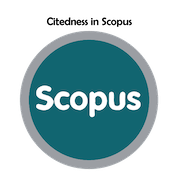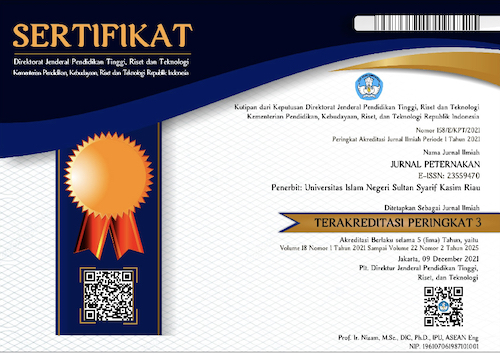Respon Inseminasi Buatan (IB) dan Kawin Alami (KA) Kambing Perah Persilangan Peranakan Etawah dan Senduro terhadap Litter Size, Tipe Kelahiran, dan Rasio Jenis Kelamin Anak Per Kelahiran
Abstract
ABSTRAK. Penelitian ini bertujuan untuk mengetahui respon Inseminasi Buatan (IB) dan Kawin Alami (KA) pada ternak kambing terhadap tipe kelahiran dan rasio jenis kelamin per kelahiran. Observasi dilakukan pada persilangan kambing Peranakan Etawa dan Senduro. Data yang digunakan merupakan data sekunder yang berasal dari 71 data kelahiran kambing yang terdiri dari 35 data kelahiran hasil IB dan 36 data kelahiran hasil KA. Observasi dilakukan tanggal 1 September 2019 hingga 31 Desember 2021. Analisa statistik dilakukan dengan menggunakan uji chi kuadrat terhadap parameter-parameter tipe kelahiran (single, twin, dan triplet) serta rasio jenis kelamin anak kambing perkelahiran (jantan dan betina). Hasil analisa menunjukkan tidak terdapat perbedaan yang nyata (P>0,05) antara IB dan KA terhadap tipe kelahiran dan jenis kelamin anak kambing per kelahiran. Dapat disimpulkan jika inseminasi buatan pada kambing akan memberikan peluang yang sama dalam menghasilkan prolifikasi serta rasio jenis kelamin sebaik perkawinan alam.
The Response of Artificial Insemination (IB) and Natural Breeding (KA) Cross of Etawah and Senduro to Litter Size, Type of Birth, and Sex Ratio of Birth
ABSTRACT. This study aims to determine the response of Artificial Insemination (IB) and Natural Breeding (KA) in goats to the type of birth and the sex ratio per birth. Observations were made on crosses of Etawa and Senduro Crossbreed goats. The data used is secondary data derived from 71 goat birth data consisting of 35 birth data from artificial insemination and 36 birth data from natural breeding. Statistical analysis was carried out using the Chi square test on the parameters of the type of birth (single, twin, and triplet) and the sex ratio of the goats giving birth (male and female). Observations were made from September 1, 2019 to December 31, 2021. The results of the analysis showed that there was no significant difference (P>0.05) between IB and KA with respect to the type of birth and sex of the goats per birth. It can be concluded that artificial insemination in goats will provide the same opportunities in producing proliferation and sex ratio as well as natural breeding.
Keywords: Artificial insemination, birth type, goats, prolificacy, sex ratio.
Keywords
Full Text:
PDF (Bahasa Indonesia)References
Abecia, J., Arrébola, F., & Palacios, C. (2016). Offspring sex ratio in sheep , cattle , goats and pigs: influence of season and lunar phase at conception. Biological Rhythm Research, 1016(December), 1–8. https://doi.org/10.1080/09291016.2016.1268325
Amam, A., & Harsita, P. A. (2019). Tiga pilar usaha ternak: Breeding, feeding, and management. Jurnal Sains Peternakan Indonesia, 14(4), 431–439. https://doi.org/https://doi.org/10.31186/jspi.id.14.4.431-439
Amin, M. N., Rokhayati, U. A., & Laya, N. K. (2019). Peran Inseminasi Buatan (IB) terhadap sistem perkawinan di Kelompok Tani Ternak Lembu Karomah Kecamatan Taluditi Kabupaten Phuwato. Jambura Journal of Animal Science, 1(2), 52–56.
Arrébola, F., Sánchez, M., Dolores, M., Rodríguez, M., Pardo, B., Palacios, C., & Abecia, J. (2016). Effects of weather and management factors on fertility after artificial insemination in Florida goats : A ten-year study. Small Ruminant Research, 137, 47–52. https://doi.org/10.1016/j.smallrumres.2016.03.002
Budiarto, A., Wahyuningsih, S., & Hermanto, H. (2018). Doe productivity index and sperm quality of Senduro goats. Journal of Innovation and Applied Technology, 4(1), 590–594.
Furstoss, V., David, I., Fatet, A., Boissard, K., Clément, V., & Bodin, L. (2015). Genetic and non-genetic factors related to the success of arti fi cial insemination in dairy goats. Animal, 1935–1942. https://doi.org/10.1017/S1751731115001500
Gharahveysi, S., Hamidi, P., & Abdollahpour, R. (2018). Factors Affecting the Secondary Sex Ratio of the Iranian Raeini Goats. Egypt. J. Vet. Sci., 49(1), 35–41. https://doi.org/10.21608/EJVS.2018.2549.1027
Gore, D. L. M., Mburu, J. N., Okeno, T. O., & Muasya, T. K. (2020). Short-term oestrous synchronisation protocol following single fi xed-time arti fi cial insemination and natural mating as alternative to long-term protocol in dairy goats. Small Ruminant Research, 192(May), 106207. https://doi.org/10.1016/j.smallrumres.2020.106207
Hartono, B., Hariyono, M. B., & Rochman, F. (2006). Usaha ternak kambing sebagai alternatif sumber pendapatan dan penyerapan tenaga kerja keluarga: Studi di Desa Tamansari Kecamatan Ampelgading Kabupaten Malang Jawa Timur. Journal of Indonesian Tropical Animal Agriculture, 3(2), 99–104.
Hassan, M. R., Talukder, M. A. I., & Sultana, S. (2010). Evaluation of the production characteristics of the Jamunapari goat and its adaptability to farm conditions in Bangladesh. The Bangladesh Veterinarium, 27(1), 26–35.
Hoesni, F. (2015). Pengaruh keberhasilan Inseminasi Buatan (IB) antara sapi Bali dara dengan sapi Bali yang pernah beranak di Kecamatan Pemayung Kabupaten Batanghari. Jurnal Ilmiah Universitas Batanghari, 15(4), 20–27.
Kaunang, D., Suyadi, S., & Wahjuningsih, S. (2011). Analisis litter size, bobot lahir dan bobot sapih hasil perkawinan kawin alami dan inseminasi buatan kambing Boer dan Peranakan Etawah (PE). Jurnal Ilmu Ilmu Peternakan, 23(3), 41–46.
Khalifa, E. I., Ahmed, M. E., Abdel-Gawad, A. M., & El-Zelaky, O. A. (2010). The effect of insemination timing on fertilization and embryo gender in Zaraibi Goats. Journal of Physiology & Reproduction, 5(1), 271–281.
Kharche, S. D., Jindal, S. K., Raju, P., & Kumar, S. (2013). Fertility following frozen semen artificial insemination in jamunapari goats Fertility following frozen semen Artificial Insemination in Jamunapari goats. Indian Journal of Animal Sciences, 83(10), 1071–1073.
Kumar, S., Chandra, R., & Madhav, K. G. (2020). Analysis of factors affecting multiple births, abnormal kidding, litter size, and sex ratio in Alpine Beetal goats. Journal of Entomology and Zoology Studies, 8(2), 1594–1596.
Lailia, N., Rondhi, M., & Soejono, D. (2020). Analisis rantai pasok dan strategi pengembangan susu kambing pasteurisasi di Goatzilla Farm & Cafe. Forum Agribisnis, 10(1), 11–26. https://doi.org/10.29244/fagb.10.1.11-26
Najmuddin, M., & Nasich, M. (2019). Produktivitas induk domba ekor tipis di Desa Sedan Kecamatan Sedan Kabupaten Rembang. Ternak Tropika, 20(1), 76–83. https://doi.org/10.21776/ub.jtapro.2019.020.01.10
Nuraini, D. M., Prastowo, S., & Widyas, N. (2021). Reproductive performance comparison between natural and artificial service in Jawarandu goat Reproductive performance comparison between natural and artificial service in Jawarandu goat. IOP Conference Series: Earth and Environmental Science, 637, 1–4. https://doi.org/10.1088/1755-1315/637/1/012028
Pellicer-rubio, M., Boissard, K., Forgerit, Y., Louis, J., Luc, J., & Leboeuf, B. (2016). Theriogenology Evaluation of hormone-free protocols based on the “male effect” for arti fi cial insemination in lactating goats during seasonal anestrus. Theriogenology, 85(5), 960–969. https://doi.org/10.1016/j.theriogenology.2015.11.005
Pellicer-rubio, M., Leboeuf, B., Bernelas, D., Forgerit, Y., Louis, J., Bonn, J. L., Senty, E., Breton, S., Brun, F., & Chemineau, P. (2008). High fertility using artificial insemination during deep anoestrus after induction and synchronisation of ovulatory activity by the “male effect” in lactating goats subjected to treatment with artificial long days and progestagens. Animal Production Science, 109, 172–188. https://doi.org/10.1016/j.anireprosci.2007.11.026
Plakkot, B., Mohanan, A., & Kanakkaparambil, R. (2020). Prolificacy in small ruminants. Journal of Dairy, Veterinary, & Animal Research, 9(3), 85–90. https://doi.org/10.15406/jdvar.2020.09.00284
Polák, J., Mareš, V., Konrád, R., & Frynta, D. (2015). Offspring sex ratio in domestic goats: Trivers-Willard out of natural selection. Czech Journal of Animal Science, 2015(5), 208–215. https://doi.org/10.17221/8170-CJAS
Rachmawati, A., Ismaya, I., Widyobroto, B. P., Bintara, S., & Susilawati, T. (2018). Aplikasi inseminasi buatan pada induk sapi potong menggunakan semen cair sapi Peranakan Ongole dengan pengencer Cauda Epidydymal Plasma-2 + 0 ,6% Bovine Serum Albumin. Jurnal Ilmu Ilmu, 28(3), 247–258. https://doi.org/10.21776/ub.jiip.2018.028.03.08
Rifa’i, & Anggriawan, R. (2020). Performa BCS induk kambing pe dan senduro di UPT TP dan HMT Singosari Malang. Prosiding Seminar Nasional Kahuripan I, 181–184.
Riyadhi, M., Rizal, M., & Wahdi, A. (2017). Diseminasi teknologi Inseminasi Buatan menggunakan semen kambing Peranakan Etawa (PE) dengan pengencer air kelapa muda dan kuning telur di Kecamatan Bati Bati Kabupaten Tanah Laut Kalimantan Selatan. Panrita Abdi: Jurnal Pengabdian Kepada Masyarakat, 1(2), 125–130.
Rusdiana, S., & Adiati, U. (2021). Pengelolaan sumber daya genetik kambing sebagai potensi biologik dan nilai ekonomi. Jurnal Sain Peternakan Indonesia, 16(2), 222–227.
Sodiq, A., & Sumaryadi, M. Y. (2002). Performans reproduksi Kambing Kacang dan Peranakan Etawah di Indonesia (pp. 52–59).
Sumadiasa, L. I. W., Zainuri, L. A., Yuliani, E., Arman, C., & Nugroho, M. P. (2019). Introduksi teknologi inseminasi buatan pada ternak kambing di Kecamatan Batu Keliang Utara Kabupaten Lombok Tengah. Jurnal Abdi Insani, 6(2), 187–198.
Tambing, S. N., Gazali, M., & Purwantara, B. (2001). Pemberdayaan teknologi inseminasi buatan pada ternak kambing. Wartazoa, 11(1), 1–9.
Trisunuwati, P., & Sudjarwo, E. (2017). Artificial insemination of Senduro goat as genetic preservation and dissemination of varian processed milk goat products at Lumajang District. Journal of Innovation and Applied Technology, 3(2), 455–458.
Utomo, S., & Rasminati, N. (2012). Penerapan teknologi inseminasi buatan pada ternak domba. Inotek, 16(1), 1–9.
Yotov, S. A., Velislavova, D. V, & Dimova, L. R. (2016). Asian Paci fi c Journal of Reproduction. Asian Pacific Journal of Reproduction, 5(2), 144–147. https://doi.org/10.1016/j.apjr.2016.01.011
DOI: http://dx.doi.org/10.24014/jupet.v19i2.17061
Refbacks
- There are currently no refbacks.
Jurnal Peternakan has been accredited by Sinta 3 : Number 158/E/KPT/2021
Starting from Vol. 18 No. 1 Year 2021 to Vol. 22 No. 2 Year 2025
Jurnal Peternakan Indexed By:
Editorial Office:
Jurnal Peternakan
Faculty of Agriculture and Animal Science, State Islamic University of Sultan Syarif Kasim Riau.
H.R. Soebrantas street KM. 15,5 Panam – Pekanbaru city.
E-mail: jurnal.peternakan@uin-suska.ac.id
ejournal: http://ejournal.uin-suska.ac.id/index.php/peternakan

Creation is distributed under the Creative Commons Attribution 4.0 International License. View Mystats














